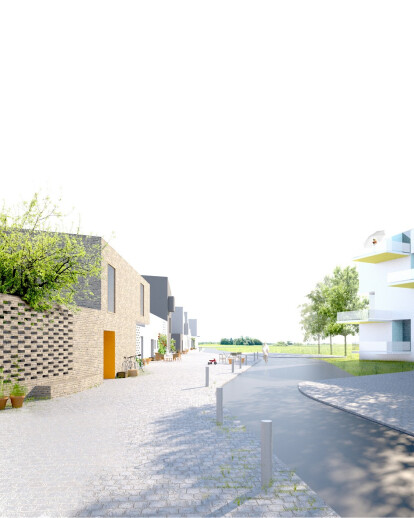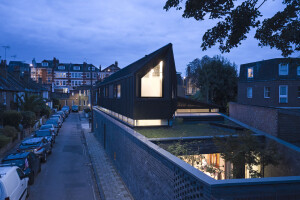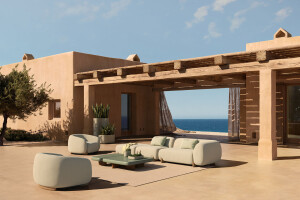A NEW NEIGHBORHOOD: VISION How can we incorporate nature into architecture, not as a part of a generic “program” but as experience intimately related to life? Nature can be a daily call, reminding us of a timeless knowledge. A call to rediscover what it has always been there and yet appears different everyday: the sea, the horizon, the trees, the clouds. The design of a new neighborhood in Humlebæk must listen to the earth that holds it, must insist in incorporating new parameters other than economy, mobility..etc. Turning our eyes into the foundational values of nature should be done without nostalgia: we do know now that good cities can make us free, complete. In this new addition to Humlebæk we have a unique opportunity to combine both worlds, nature and the city. Louisiana has shown us a way. Louisiana invites us to listen, reflect and contemplate. These are introverted, intimate experiences, but they occur in an environment that is eminently public. Its architecture invites us to a reflective pause that accompanies and favors experience. Our new Humlebæk neighborhood should also aspire to be a privileged place to witness the raise and fall of the sun, the flow of seasons.
THE HEIGHTS At The Heights we will make use of the open space, the astonishing views, the big common green. We will enjoy an open realm where spontaneous interaction can appear. Where you can run, read, kiss, watch a concert on a summer evening, and take long walks with your child. Once the company of nature is secured, we can try new forms of urbanity. The Heights will live side by side with a very popular urban model in Denmark: the single family house sprawl. This model is by definition unsustainable, a waste of territory, of energy. It expands horizontally to create a landscape without quality. A short sighted, narrow-minded landscape, that doesn’t go beyond our own backyard. Born from a legitimate desire (to get out of the city), suburbia as we see it in parts of Humlebæk, fails also from a social point of view. There is no place for the richness of Main Street, the culture of commercial promenading, the humanity that filters trough the mix of functions and people. The detached house quarter is tailored for people same age, same income. The Heigths will bring back the friendly side of the city, the small town easiness that suburbia lacks. The grocery, the hair dresser, the bakery, the gym, the cinema, the architect’s studio. To prove that, after all, as Venturi said “Main Street was almost all right”. Both our new boulevard and the streets advancing into the landscape will enhance and extend the urban structure. The desired mixture of living, working, shopping, appears. At the same time these elements relate to the bigger picture: Humlebæk.
DESCRIPTION The project offers a wide variety of housing types, to address the multiplicity of today’s demand, from singles to families, seniors, etc. Different ownership and renting models will further ensure social mixture and diversity. We find two main typologies: multifamily housing (collective housing) and a “dense-low” lay out. The collective housing ensures with its very generous balconies good contact to the street and the landscape. Within the same building, different types and sizes of flats coexist (from minimum to maximum). The dense low scheme varies from one to two floors and up to tree floors in some cases. THhe open courts or gardens face the open landscape towards the south. Each “pocket” formation invites the landscape in, creating an open neighboring space for play and recreation in continuity with the open landscape.
Street life: Towards the west the streetscape offers a different type of interaction. Outside your front door, late afternoon sun and sunsets can be enjoyed in a situation that reminds us of Dragør or Brumleby with the decisive added element of the contact to the generous landscape. The street is not a transport corridor but an important public space where life unfolds. The buildings emphasize the experience. The façade line twists and breaks slightly, a variation of typologies and materiality sets the frame for the streetscape. From the street we experience the life in the houses and vice versa, through the partial permeability of the courts and balconies. The qualities of the street, the late light and informal meetings are further qualified by a variety of urban functions: playgrounds, drinking fountains, flowerbeds and benches. All this helps shaping “the good life” in the new neighborhood.
Continuity: The lay out allows unhindered movement between three different levels or steps of human interaction both in relation to privacy and in relation to nature.
Home: private realm Neighborhood: community City and landscape: public space.
The boulevard The boulevard is Humlebæk´s new space for recreation and public life. It connects the existing building areas North, East and West of the new neighborhood. The linear plantation is crossed by motion tracks, bicycle and pedestrian paths. At the boulevard, the landscaping acquires urban character. The density of programming makes the boulevard a natural part of Humlebæk addressing all its inhabitants. Different sport fields, playgrounds for young and old lay along the boulevard. It is also the place for creative development and quieter or more contemplative situations. Both existing school benefit from the boulevard facilities. The new neighborhood grows naturally from the extension of three existing streets (Bogårdsvej, Boserupvej and Baunebjergvej) towards the South. At the meeting of these streets with the boulevard, the scheme gains density. The buildings are then organized around three squares constituting the effective connection to the existing city and concentrating urban life.
Urbanity revisited The project reestablishes, within a suburbial context, two key components of the urban experience: the boulevard and the street.
A. Urbanity 1: the boulevard. A1.The boulevard as promenade: A sequence charged with experiences, with nature as background: again the example of Louisiana. Pavilions, art, sports, leisure. In the boulevard we scenify and communicate our environmental responsibility: ecoboulevard.
A2. The boulevard as concentration of the public-collective: In the three main hubs or squares, sharing, learning, information, work, shopping, leisure, takes place.
B. Urbanity 2: the street . We think that a street is more than a house. Streets have a character. While a villa could succeed in transmitting individual identity, the street starts transmitting collective identity and reflects a common aspiration. We share a street and feel co- responsible about it. Streets have names. The peculiarities and richness of Humblebæk´s nature will give identity and differentiate the streets of “the heights”. But they will all have a beautiful end: Humlebæk´s open landscape.
A more holistic approach to Sustainable development From Green Economy to Resource Economy
What we have to date considered as sustainable or ’green’ development has, for the most part, focussed on the natural environment, the energy and technology sectors or a combination of these; green-tech, clean-tech etc. ’Green economy’ has considered nature (earth, water, minerals, air) and renewable energy (exploiting without damaging nature) as its primary ’green goods’. There remains, however, a vast amount of man-made material and people-related resources which are in constant use and circulation but which until recently have fallen outside the sustainability radar. These are resources which we purchase, own and use, at high frequency and high volume and which support our everyday contemporary lives. Plastics, metals, electronics, building parts, buildings, streets, human labour and time. The carbon embodied or attributed to these resources significantly outweighs the carbon we use when we buy food to eat or kilowatt hours to heat.
Integrating resource-thinking and planning strategy for Humlebæk Make more use, release more resources
1. EVERYDAY PRODUCTS, GOODS & SERVICES A community can replace the purchase and ownership of many individual household products and possessions by ‘pooling’ a series of fewer, higher quality articles for sharing within the community. SUPER-BASKET provides local, organic food delivery to many households at once. People only buy what they eat, each day. Purchase is per kilo and return of organic waste is registered and rewarded as credit per kilo (SUPER-RETURN). SUPER-FRIDGE is a community sized fridge which is always full. People buy milk, cheese etc. per unit volume or unit weight each day. This reduces food waste and saves transport to/from supermarkets. SUPER-CLEAN is a shared cleaning service which allows households to pay either for home-cleaning or for a share in environmentally approved cleaning products, or both. Again, people pay per unit volume of say, cleaning detergent, tapped from a common tank. This avoids lots of unnecessary packaging and means kitchen cupboards don’t get filled up with half-full plastic bottles. SUPER-FIX is a community sized tool box which allows people to buy the use of a common set of high performance tools instead of having to buy their own. The less time you use the tools and the faster you return them, the less you pay. A professional craftsperson is available to help you with your projects for one evening and one Saturday morning every fortnight. You bring your project to the community tool box, rather than vice versa. There is a large roof cover to enable many projects to be accommodated simultaneously.
2. DESIGN THE LIFE OF BUILDINGS, NOT JUST BUILDINGS 2.1. fast cycle building use
By doubling (or tripling) the use of space, services, products and equipment, we can increase the quality of life for people whilst significantly decreasing the throughput of resources and net emitted carbon. Quality of life is increased by increasing the amount of different activities which one space can provide during one day or week. For example, a space housing a kindegarten during the day, doubles-up as an adult learning centre or shared work-lab during the evening. A secondary school (folkeskolen) can fulfill the needs of its own pupils during the day; sports hall, music room, computer lab and then fulfill the same needs of other, different groups of people during the evening. Maximizing the use of the same spaces and the objects within them enables sharing amongst a multiple of users, thus eliminating the reason to purchase new articles and occupy, heat and service other spaces elsewhere. This leads to huge net savings in the materials and energy used and the tons of carbon emitted as a result. When a building’s function and its users change many times during one day or week, we have a high frequency changeover which we can consider as fast cycle use. When we program key, centrally located buildings with fast cycle use, this can have spin-off benefits to the public realm surrounding it. When the intensity of activity in the building(s) increases, then the number of people moving through and spending time in the spaces surrounding the building increases too. This allows more people to contribute to the life of public space and to the vitality of the city or neighborhood as a whole.
2.2. slow cycle building use
Slow cycle use is when we design buildings to accommodate a multiple of functions over a longer time frame. This, in the long-term, can save a significant amount of resources; time, labour, energy, materials and waste, since the buildings use can be adapted in accordance with user need or market demand quickly, easily and with relatively low labour intensity and cost. The challenge here is how to offer a high degree of adaptability whilst at the same time ensuring permanent quality within the spaces themselves. This can be achieved by designing and embedding core qualities in the building’s primary structure. These core qualities include generous floor to ceiling heights, high day light intake and penetration, easy and close access to service cores etc. In Humlebæk syd we propose these types of buildings placed in the boulevard and spread amidst the housing scheme. Development will start with a few clusters of high density buildings. These buildings can and should be of different scale and proportions in order to shape different pockets and strips of public space on the ground plan. However, all these buildings can be generic building typologies, that is they can contain (within reason and limited by common sense) anything from apartments to offices to school class rooms to shops to dentist clinics.
“The promenade” as productive landscape
Orange (kålrabi) + blue-black (blackberries) + red-green (apples) This can be used to grow one root vegetable (kålrabi), one bush fruit (skovbær) and one tree bearing fruit (apples). This is an “opportunistic” planting strategy that takes advantage of a relatively narrow width of land and uses it for agriculture. However, the net yield of this productive landscape is not the only aim. In an urban setting, there are a series of other advantages as follows: - using the land to receive compost from household organic waste - focussing on educational activities based on growing, collecting and distributing local produce for local consumption in the surrounding neighborhood - focussing the community at large in the above activities - connecting to a wider network of local and larger scale activities, linking them to promote educational initiatives and to divert local foods directly to the new neighborhood.




























